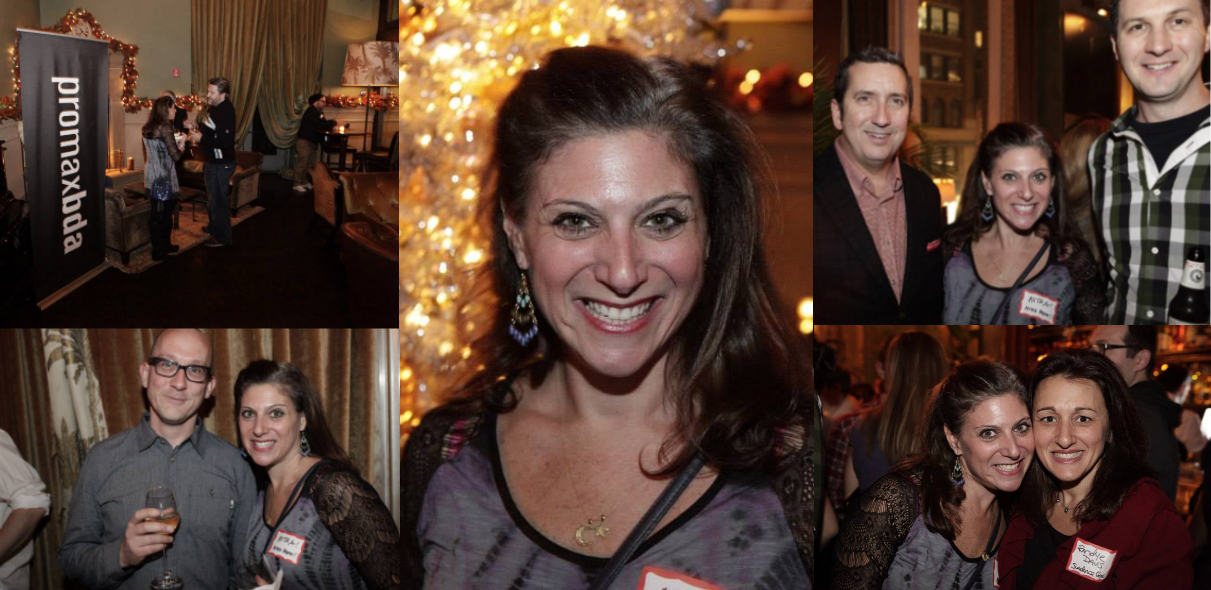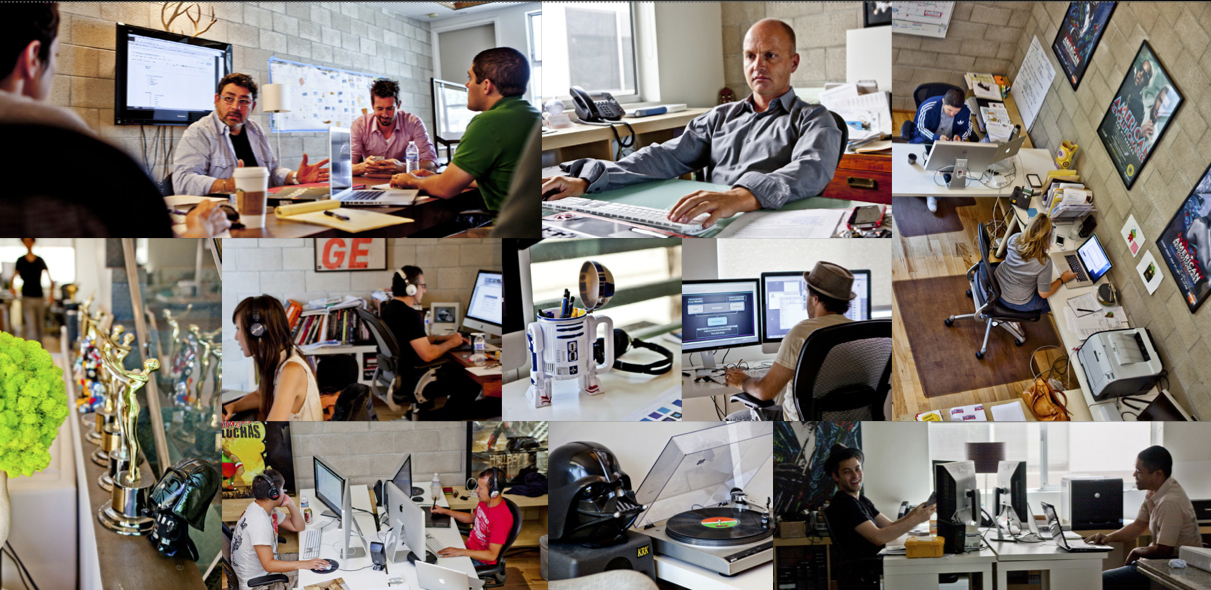THE BLOG
Feb
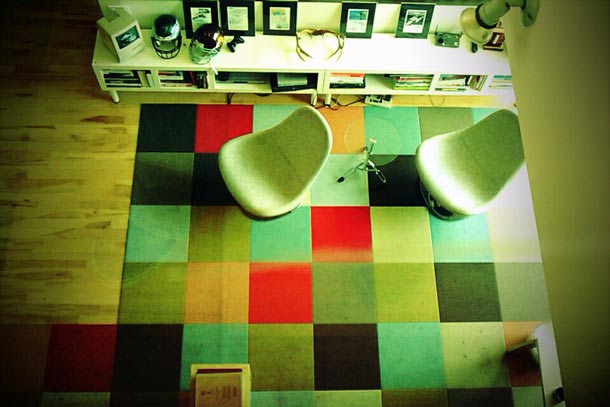 Our VP, Kate Canada Obregon, wrote a blog post on “Five Tips for Making Your Office a Creative Space,” which appeared in The Agency Post today.
Our VP, Kate Canada Obregon, wrote a blog post on “Five Tips for Making Your Office a Creative Space,” which appeared in The Agency Post today.
An excerpt:
Here are five elements that can contribute to making your space the type of generative office that supports and amplifies creativity:
1. Familiar People
Researchers have demonstrated that collaborative work environments create happier and more productive employees. J. Richard Hackman, one of the world’s leading researchers on organizational behavior, found group work, particularly a familiar group, to be more productive when compared to individuals who worked alone. When a familiar group is encouraged to share ideas, hear other perspectives and receive constructive feedback, they report greater satisfaction with their job, their peers and culture.
2. Collision Brainstorming
Writing in the New York Times, Greg Lindsay observes that successful tech firms know the benefits of people coming together for an impromptu brainstorm via happy accidents and aggressively seek what Google calls the “casual collisions” or Yahoo’s “serendipity” meetings. This is because research strongly suggests that structured group work has limits. In the new context of an informal chat, the brain has a chance to re-engage and renew a problem, and possibly come up with new approaches or ways of thinking.
3. Solitary Creativity
Most neuroscience studies on creativity and problem-solving demonstrate the powers of intermittent group work coupled with “incubation” or quiet time and solo work. This is where the lounge and reading areas and ping-pong tables that startups are famous for come in. After a group meeting, the brain needs some distraction and ambient activity to reassess a problem or create. Neuroscientists such as Rex Jung and others have studied the brain in “action,” and observed what is called fluid or dynamic activity in the brain during quiet times of relaxation and calm, which could yield high creative output benefits.
4. Tactile Engagement
If you consume lots of data everyday and need to recall information quickly, there’s new research showing that keeping information slows down our ability to remember and process. One powerful method for what is called “embedding” information is getting tactile at work. Embracing the old-school pen and pencil during a meeting, or taking marginalia in a book can code information into our brains in ways that author Clive Thompson suggests are deeper and more meaningful than on touchscreens. That’s why writable walls, movable whiteboards and active work sessions are excellent ways at getting the brain and body physically involved in learning and doing, fostering neuron activity in the brain.
5. Good Reading Materials
A well-stocked library in your office gives people places to relax between projects, but reading has other powerful cognitive benefits. Recently, researchers at Emory University observed changes in the executive functional part of brain in fiction readers. Participants in the study showed heightened neural activity in the part of the verbal and visual sections of the brain when reading. So, not only were subjects able to “imagine” a character, they were able to activate senses in their brains — deepening their awareness and imaginative capabilities.
See more at The Agency Post.
Feb
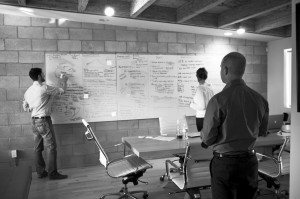 For 60 years, the open office floorplan has been both the standard and ideal for office design. Mirroring economic changes since the 1950s and into the 1990s, architects have designed work environments for the booming “knowledge industries,” spaces where people create and produce ideas as part of their company bottom lines.
For 60 years, the open office floorplan has been both the standard and ideal for office design. Mirroring economic changes since the 1950s and into the 1990s, architects have designed work environments for the booming “knowledge industries,” spaces where people create and produce ideas as part of their company bottom lines.
Symbolically speaking, people like to work in open office spaces, because they report feeling connected to the company’s organizational mission and to their fellow office mates. These spaces do well at creating “communities.” And while the intangible benefits are apparent, studies conducted by organizational psychologists on large corporations show mixed results on the measures of productivity.
Workers in open offices complain most often about noise, loss of privacy and constant distraction. What open floorplans do really well for creative industries is provide two key components: Collisions and Quiet.
* Collisions or happy accidents among workers can happen anywhere from a meeting to lunch, coffee or a chance meet-up in the hallway. Researchers have shown that these collisions can be methods to generate fertile conversations and move along ideas previously discussed.
* Quiet is incubation time. Many problems or ideas people are tasked to bring to market require vast amounts of time. This is because the creative process has many stages, one of which is when ideas go into hiding, or into unconscious activity and emerges again in a new context; in a meeting, for example.
Kevin Johnson has said “Chance favors the well connected.” By that, we think he means the office that is open in connectivity, but also open to the processes required for real creativity and innovation.
We cannot create without other people. We are social animals. Some philosophers and scientists argue that physical and sensorial evocative environments act like our scaffolding into the world, giving us humans opportunities to deepen our brain activity and expand into the world.
What is your office experience like? Do you think it fosters collaboration and ideation?
Feb
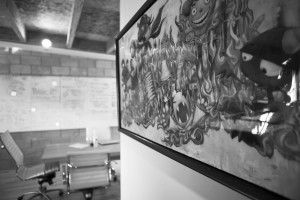 Many people have asked us about the meaning behind the need to “think like a tourist” — a topic we’ve covered before on our blog. It sounds fun and slightly risky, but what is it? How does it help people come up with innovative solutions? Push along a brainstorming session? How does thinking help people think creatively?
Many people have asked us about the meaning behind the need to “think like a tourist” — a topic we’ve covered before on our blog. It sounds fun and slightly risky, but what is it? How does it help people come up with innovative solutions? Push along a brainstorming session? How does thinking help people think creatively?
“Thinking like a tourist” is what psychologists and scientists refer to as the attitude of perceptual innocence. Basically, it’s a learned method of thinking and ideation; of looking at ordinary objects around us, focusing on their details and then letting the mind wander gently to make connections, or even make remote or obscure links to the object. Once learned and practiced, it opens the door to playful thinking and experimentation, and can be brought back to any number of problems we are playing with on any given day.
Think of it this way: it’s like waking up in a new city. Walking out of your hotel room and tossing out the GPS. It’s taking in the smells, sights and sounds. Your senses see the ordinary sights in a new context. And in the process, you awaken new connections, such as finding the best corners to explore and visit.
There are any number of creativity techniques: divergent thinking, vertical thinking, and lateral ideation. Thinking about the ordinary in extraordinary ways opens up new possibilities, and takes us into the unknown.
Try this “tourist” technique today — and notice how differently your everyday world and situations look to you.
Feb
Inspired thinking starts with looking at the world differently. It can come from within ourselves, but it’s often more fun when it comes from artists — visual artists, such as Stanley Kubrick, for example. Kubrick invites us to see our daily lives by way of visual cues and patterns. It’s always a jolt to the system and at the same time, a hilarious (and enlightening) way to feel and experience.
Kubrick’s creative visionary mind and methods of thinking are akin to some of today’s tools:
• Boxes are a tangible version of Google and other search engines.
• His photography requests resemble Google maps.
• His late night memos resemble texts or tweets.
Just watch this documentary on Kubrick to see what we mean. And let us know what you think. How are you seeing the world in a different way?
Stanley Kubricks Boxes from JAVARING on Vimeo.
Jan
 This week, one of the world’s most respected newspapers, The New York Times refreshed and re-launched their digital platform to mostly positive reviews. Fast Company characterized the visual refresh as somewhat exciting compared to the previous decade-old design. Others pointed to the back-end changes, re-styled pages and “sections” and navigation adjustments as necessary moves to moor the company in the rough waters of decreasing sales, increased competition and slackening advertising rates for digital newspapers.
This week, one of the world’s most respected newspapers, The New York Times refreshed and re-launched their digital platform to mostly positive reviews. Fast Company characterized the visual refresh as somewhat exciting compared to the previous decade-old design. Others pointed to the back-end changes, re-styled pages and “sections” and navigation adjustments as necessary moves to moor the company in the rough waters of decreasing sales, increased competition and slackening advertising rates for digital newspapers.
We generally like the design and navigational changes. The look and feel of the refreshed home page is less like the “swarm” of ink of the old design and presents a clean, measured and even engaging experience. With the new navigation features, scrolling through an article no longer requires clicking and reloading into new pages, which made for a choppy reading experience. But beyond the aesthetic, and even the functionality improvements of the refresh, what we find most interesting about the new site is what the changes say about the status of The Times in our culture and the newspaper world.
“We are seeing a company retool and experiment in the laboratory of design, media and branding, and in the end, this is about larger strategic issues,” Kate Canada Obregon, Oishii’s Head of Research and Strategy explained. “The New York Times is actively pursuing its once coveted leadership role in our changing world, and is using the discipline of design to get there.”
Oishii’s President and Chief Creative Officer Ish Obregon agreed, pointing out how even small details like the new smooth integration of the comments alongside the articles, which he says creates a “rich and textured” feel to the reading experience, is all part of a bigger news delivery goal. “From a design perspective, this is a very small step toward a blog look, without losing the power and stature of the new,” Ish said. “And great design strengthens the delivery of news.”
The Times has arguably been one of the most important leaders in the distribution of news. As it wields such formidable power, it also creates and shapes expectations about reading, how we get our news and how we recognize what’s important.
The New York Times redesign is a way for it to once again be a leader in reimagining news, reading and information delivery. Its role has always been to report facts, tell stories and inform us about our world, but in this new digital era, it’s also subtly taken on another role – to deliver “all the news that’s fit to print” through a fresh, innovative and powerful design harnessed through the most creative use of technologies.
Jan
 Happy New Year! Please meet Gina Young, one of our copywriters at Oishii:
Happy New Year! Please meet Gina Young, one of our copywriters at Oishii:
1. What was your first paying job doing what you love?
My first real, grown-up writer job was for Pop Up Video on VH1, which was exactly as fun as you would imagine it to be. But the first time I remember getting paid to be creative was when I was in fourth grade. I got to leave school early (no way!) to sing a song in a real recording studio… and from that moment on I was so eager to get out in the real world and learn by doing. I quickly became the kid who was always writing and self-publishing zines, making music and putting it out on cassettes, or putting on plays with my friends. Do-it-yourself all the way.
2. What inspires you in your work?
Language itself, I think. Writing is like problem-solving; rearranging words, and with every word you add or subtract you can completely change the meaning or the feeling of a thing.
3. What are your favorite types of projects?
My favorite types of projects are things that haven’t been done before, or things that have only been done in a way that I want to turn on its head. I’ve been writing a lot for the stage lately (see links below), but I also like writing web content and am working on a feature-length screenplay.
4. What is your ideal working environment?
I do my best writing on trains and public buses. Coffee shops can be nice too, because it feels like a co-work space where a bunch of us are all writing together. I’m very excited to finally — this weekend! — get benches for the little breakfast nook in my new apartment. It’s going to be such a good workspace for me; a nice rectangular table, tons of light, but it’s very claustrophobic and womb-like. Haha.
5. What artists inspire you?
Artists and playwrights whose work I’ve been returning to a lot recently include Keith Haring, Tom of Finland, Frida Kahlo, Caryl Churchill, Maria Irene Fornes, Anna Deavere Smith… I’m also very inspired by the work of Los Angeles choreographer Ryan Heffington. I had the pleasure of producing a recent dance concert at his studio and look forward to doing the next one in February 2014.
6. What companies do you like to work for?
The best companies are the ones that are open to new ideas and to change, that embrace social media and that do everything in a spirit of collaboration. And of course, the closer as I can be to the arts/film/TV, the better.
7. How do you like to work? As a freelancer? Alone? In an office environment?
I prefer to work alone, but I also love collaboration. I’m a freelancer by nature because I need new stimulation every day. Some of the best days of my life were when I was traveling or touring; I love falling asleep in one city and waking up in the next. I’m not a huge fan of routine, although I do value discipline and long hours.
8. What kind of mentoring do you find most helpful to you?
I wish I had more mentoring in my life! I think the best mentor is one who listens to your goals and doesn’t impose their will on you, but can still be super real about where they think you should be focusing your energies, and what steps you should or shouldn’t take.
LINKS:
Dec
We’re deep in the holiday season! Parties, lists, gift giving and receiving and plenty of ways to jangle your fa-la-la-la-la’s We’ve asked licensed therapist Nicole Shannon to give us her expert advise, her time tested ways to celebrate and stay creative and productive during the season.
Happy and Delicious New Year!
At the end of the year, lots of deadlines are upon us. What are the best ways to balance work and personal commitments this time of year?
The best way to stay balanced during the end of year hustle and bustle is to be mindful of what you’d like to accomplish and how you want to feel when you’re ringing in 2014. If you want to ring in the new year the same “exhausted” and “busy” way you watched it roll out then continue doing what you’re doing, but you can remain connected to yourself and others even though there are deadlines and commitments up ahead. The number one pitfall we all make is to over commit ourselves and in the process we disappoint ourselves and others. Don’t over commit, ask for help, and start by getting comfortable with the word, “no”. Balance is a state of mind we achieve when we’re being true to ourselves.
Holiday parties means lots of shmoozing and socializing. What suggestions do you have for having fun while still being professional at the work events? Depending on your introvert or extrovert status, holiday parties can be fun or torture. Either way, you can have your type of fun and feel comfortable come Monday. First and foremost, keep it classy. Choose your outfit wisely and keep in mind you’re headed to an office party not the nightclub. Self-monitor as much as possible or hang with a friend who can assist you with that if you feel the temptation to indulge will be too strong. Keep the conversations pleasant and upbeat and have a time limit in mind. Typically, nothing good happens after midnight.
How can people enjoy the holidays and get everything accomplished on their “to do” list? If your “to do” list is reasonable then you should be able to enjoy the holidays and get everything done. It’s always important to have realistic goals though. Look at your to-do list and ask yourself a few questions, 1) Do I really need to accomplish everything on this list? 2) What will happen if I don’t get everything done? 3) Am I too focused on checking things off my list that I’m forgetting about the important things? Nothing feels better than checking things off our list, but we sometimes focus on the “lists” more than our time connecting to those around us.
What are some good ways to stay creative and productive during the holidays? Stress and overwhelm are two sure fire ways to zap creativity. In order to keep your creative juices flowing during the holiday season make sure you’re creating space both internally and externally. The internal and external space need to be congruent. So many times I have people telling me that they don’t understand why they’re not feeling inspired and once we take a peek at their internal and external worlds we can see why it’s so uninspiring. If you’re just rushing from place to place and not creating space for self-care then I’m sure you’re not creating space in your life for inspiration. Connection to self and others is what inspires creativity as well as taking the time away that you need to be quiet and thoughtful.

